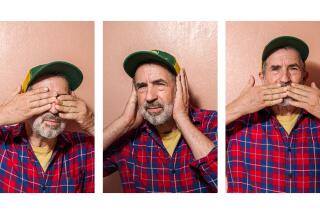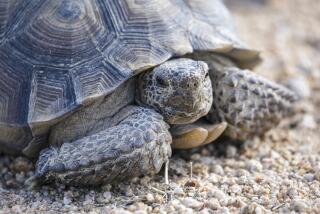Rare tortoises are branded to make them unattractive to poachers
The booming illegal international wildlife trade forced conservationists to do the unthinkable Tuesday: Brand the golden domes of two of the rarest tortoises on Earth to reduce their black market value by making it easier for authorities to trace them if stolen.
âItâs heartbreaking that itâs come to this, but itâs the right thing to do,â Paul Gibbons, managing director of the nonprofit Turtle Conservancyâs Behler Chelonian Center in Ventura County, said as he gently placed a 30-pound adult female ploughshare tortoise on a small table.
With a steady hand and an electric engraving tool, he carved an identification code on the high, rounded shell as the creature with weary eyes and gleaming carapace peered calmly into the distance. The tortoise was branded for life, which in her case would be roughly 160 years.
PHOTOS: Marking rare tortoises
âWeâve blemished her natural beauty, so sheâs just a number in a system now,â Gibbons said. âNo. 7001 MG.â The 2-inch- by-1 1/2 -inch block figures were placed at the top of the turtleâs back, a location chosen to avoid interfering with the expansion of the shell, which grows at the edges.
The conservancyâs goal is to mark every one of the estimated 360 ploughshares in captive breeding programs around the world and the 300 believed to be remaining in the wild.
So far, no rare tortoise or turtle with identification markings has turned up in illegal markets monitored by law enforcement authorities, conservationists said.
Decades of intense collecting, hunting and habitat destruction have brought that species and dozens of others to the brink of extinction. Now, sanctuaries and zoos are using visible identification marks â shell notches, clipped toenails, paint, laser inscribing, tattoos and engraving â as a tool to fight poaching and dissuade wealthy collectors willing to pay tens of thousands of dollars for critically endangered turtles and tortoises.
The shells of two confiscated ploughshare tortoises were engraved at the Singapore Zoo in December. In October, the Turtle Conservancy helped mark the shells of 150 Burmese star tortoises in Myanmar.
Keeping rare turtles and tortoises safe, however, will require a level of security that at this point is elusive at best.
A week ago, Indonesian officials at Soekarno-Hatta International Airport in Jakarta rescued more than 8,000 baby pig-nosed turtles hidden in suitcases and believed headed for China and Singapore.
In December, Royal Thai Customs officials confiscated a suitcase containing 62 rare radiated tortoises at Bangkokâs Suvarnabhumi International Airport.
In November, authorities in a Thai airport discovered 432 protected tortoises and 52 black pond turtles worth about $110,000 in unclaimed luggage arriving from Bangladesh.
In March, authorities seized 54 ploughshare tortoises found in the suitcases of two individuals attempting to enter Thailand.
Golden coin turtles have been selling for thousands of dollars each since poachers recently started claiming that consuming extracts from the species could cure cancer.
The two ploughshare tortoises marked Tuesday were flown in from Taiwan, where they were seized in 2008. The female now known as No. 7001 MG was successfully mated last year with the only male ploughshare tortoise of breeding age outside Madagascar.
Five eggs she laid in November are being incubated. They are the first ploughshare tortoise eggs produced in an international conservation program. âWe still arenât sure they are fertile,â Gibbons said.
As the rarest tortoise on Earth, the ploughshare is highly valued by global animal traffickers and fetches tens of thousands of dollars on the Asian black market, conservationists say.
The same could be said for most of the cold-blooded animals at the conservancy, a secret compound of paddocks and aquariums protected by surveillance cameras and electric wire in the foothills of Los Padres National Forest.
Although certified by the American Zoo and Aquarium Assn., the conservancy is not open to the public or listed in the phone book. The only visitors are turtle biologists from around the world.
Its primary mission is to maintain colonies of threatened and endangered tortoises and freshwater turtles, such as two Sulawesi turtles from Indonesia confiscated at Los Angeles International Airport in February. Other new arrivals include seven Roti Island snake-necked turtles, members of an Indonesian species hunted to near extinction.
Then there is Daphne, a 40-year-old female giant Galapagos tortoise looking for a mate.
As collection manager for the conservancy, it is Christine Lightâs job to pamper egg clutches until they hatch and babies until they are old enough to fend for themselves.
âThis little fella hatched on Monday,â Light said, holding up an Indian spotted turtle about the size of a 50-cent piece. âToo cute for words, right?â
âLast year, we had 294 hatchlings from 13 species,â she added with a smile. âEach one of those hatchlings was a little win for our side.â







